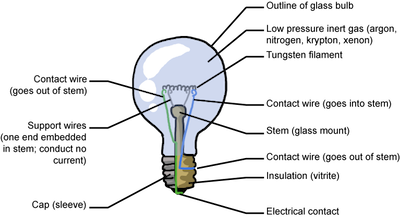The Theme of Technology in The Periodic Table
Halogens Light Bulbs
Halogen light bulbs are bright bulbs found in households and stores across the globe. In homes they're usually found in tall floor lamps, perfect for lighting a large room. How is a halogen light bulb different from a normal light bulb?

Schematic of a traditional incandescent light bulb.
Halogen light bulbs contain halogen gas, usually iodine or bromine. Compared to a standard light bulb, these bulbs are brighter and last longer. A normal light bulb lasts about 1000 hours, but a halogen light bulb can last twice as long. Not to mention they can also be more energy efficient.

Halogen light bulbs burn hotter, brighter, and longer! Image from here.
Normal light bulbs contain tungsten filaments. During operation the filament get very hot, nearly 4500oF.17 (That's really hot.) During this process the tungsten evaporates and is deposited on the inside of the bulb. You may have noticed this dark residue on a burnt out bulb. When the tungsten wire evaporates so much that the wire breaks, the bulb's life is over and it's time for a new one.

A burned out light bulb. Image from here.
In a halogen lamp, the evaporated tungsten reacts with the halogen gas in the bulb. Ultimately the tungsten gets redeposited back onto the filament. This extends the life of the filament since it takes a longer time for the filament to break and the inside of the bulb doesn't get the dark residue. The halogen gas also allows the filament to burn even hotter which produces a brighter light. (Go team halogen.)
Of course there is a slight downside to the use of halogen light bulbs. We already mentioned the filament burns hotter than in a normal bulb. This added heat is so intense that if you place the bulb too close to a flammable object a fire could start.